Below, are 8 interesting bench press statistics for 2023. I reveal good bench press weight standards to aim for, how much the average man and woman can press, and the world’s heaviest records.
1) World’s Heaviest 1-Rep Bench Press.
Key bench press stats:
- Will Barotti holds the title of heaviest flat bench press recorded, as of 2021, at 1105lbs (501.5kg).
- Tiny Meeker holds the title of second heaviest bench press, at 1102lbs (499.9kg).
The title for heaviest bench press for a single repetition (or 1 rep max) currently belongs to Will Barotti.
Will pressed a gargantuan 1105lbs (501.5kg) at The Metal Militia Powerlifting Federation in June 2020.
This is closely followed by Tiny Meeker’s previous record of 1102lb (499.9kg), which was made at the 2013 Cajun Hardcore Powerlifting Meet.
Note: 1RM refers to 1-rep max. If you don’t know what this is you can go to my other article for a full explanation of RM’s in weight training.
2) Average Bench Press By Age
Key bench press stats:
- The average man can bench press 0.75 to 1.00x of their body weight (depending on age).
- The average woman can bench press 0.45 to 0.65x of their body weight (depending on age).
- Bench pressing strength usually decreases with increasing age.
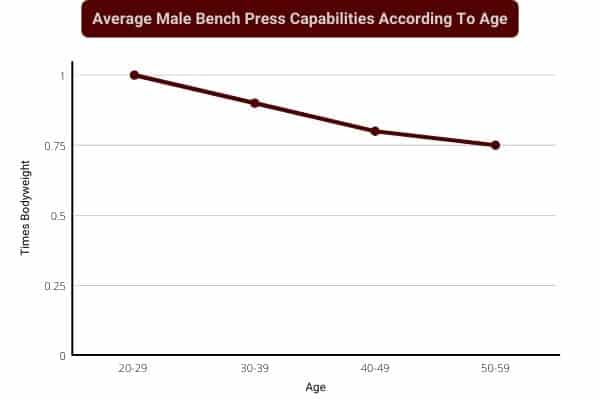
The average man can bench press 0.75 to 1.00x their own body weight. And the exact number depends on age (and of course, training level).
As a man, here is how much you should be able to bench press, according to your age:
- 20-29 years old- 1.00x your body weight.
- 30-39 years old- 0.90x your body weight.
- 40-49 years old- 0.80x your body weight.
- 50-59 years old- 0.75 your body weight.
The average female generally has 60% less upper body strength compared to men.
As a woman, here is how much you should be able to bench press, according to your age:
- 20-29 years old- 0.65x your body weight.
- 30-39 years old- 0.55x your body weight.
- 40-49 years old- 0.50x your body weight.
- 50-59 years old- 0.45 your body weight.
The average male/female bench press numbers are for the flat barbell bench press variation. You can check out my other post for dumbbell bench press standards.
3) How Much The Average Man And Woman Can Bench
The average man weighs 200lbs and the average female weighs 170lbs.
Let us also assume that the average person is a beginner-intermediate.
This is how much weight the average beginner-intermediate man and woman should be able to bench press:
| Bench Press Variation | Average Male Standards | Average Female Standards |
|---|---|---|
| Barbell flat bench press | 136lbs | 51lbs |
| Barbell incline bench press | 130lbs | 41lbs |
| Dumbbell flat bench press | 90lbs | 32lbs |
| Dumbbell incline bench press | 108lbs | 40lbs |
Dumbbell weights are for both dumbbells combined.
For more details, you can check out my other article for an in-depth weight comparison between the barbell vs dumbbell chest press.
4) Bench Press Standards For The Average US Person
Key bench press stats:
- The average US male is able to bench press between 136lbs (62kg) to 379lbs (172kg) for 1 rep, depending on training level.
- The average US male is able to bench press between 51lbs (23kg) to 231lbs (105kg) for 1 rep, depending on training level.
The average US male weighs 200lbs (90kg) and should be able to barbell bench the following weight standards for 1 rep:
| Bodyweight | Beginner | Novice | Intermediate | Advanced | Elite |
|---|---|---|---|---|---|
| 200lbs | 136lbs | 184lbs | 242lbs | 308lbs | 379lbs |
In comparison, the average US female weighs 170lbs (77kg) and should be able to barbell bench the following weight standards for 1 rep:
| Bodyweight | Beginner | Novice | Intermediate | Advanced | Elite |
|---|---|---|---|---|---|
| 170lbs | 51lbs | 83lbs | 125lbs | 175lbs | 231lbs |
Here are the same bench press numbers plotted on a graph:
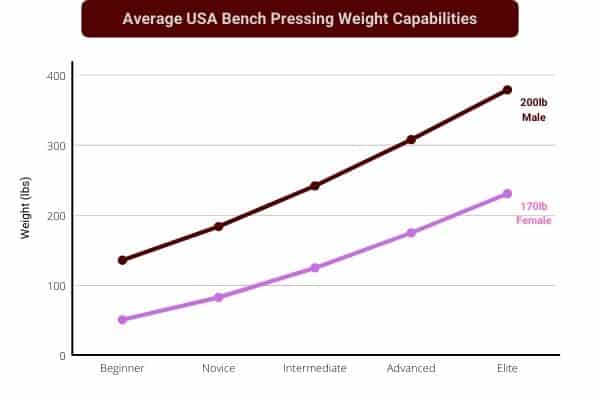
And here are the training levels defined:
| Training Level | Criteria |
|---|---|
| Beginner | At least 1 month of bench pressing experience and knows how to correctly perform the exercise movement. |
| Novice | At least 6 months of bench pressing experience and has regularly practiced the exercise movement. |
| Intermediate | At least 2 years of bench pressing experience and has regularly practiced the exercise movement. |
| Advanced | At least 5 years of bench pressing experience and is well adapted to the exercise movement. |
| Elite | At least 5 years of bench pressing experience and competes in strength competitions. |
If your bench press is near or above these weight standards, then you know you’re lifting a respectable weight!
If your bench press weight is below these averages, then you can check out my other post for reasons and solutions for a chest that won’t get stronger.
5) Bench Press Standards For The Average UK Person
Key bench press stats:
- The average UK male is able to bench press between 123lbs (56kg) to 356lbs (161kg) for 1 rep, depending on training level.
- The average UK female is able to bench press between 42lbs (19kg) to 211lbs (96kg) for 1 rep, depending on training level.
The average UK male weighs 185lb (84kg) and should be able to barbell bench the following weight standards for 1 rep:
| Bodyweight | Beginner | Novice | Intermediate | Advanced | Elite |
|---|---|---|---|---|---|
| 185lbs / 84kg | 123lbs / 56kg | 169lbs / 77kg | 224lbs / 102kg | 288lbs / 131kg | 356lbs / 161kg |
In comparison, the average UK female weighs 154lb (70kg) and should be able to barbell bench the following weight standards for 1 rep:
| Bodyweight | Beginner | Novice | Intermediate | Advanced | Elite |
|---|---|---|---|---|---|
| 154lbs / 70kg | 42lbs / 19kg | 71lbs / 32kg | 110lbs / 50kg | 157lbs / 71kg | 211lbs / 96kg |
Here are the same bench press numbers plotted on a graph:
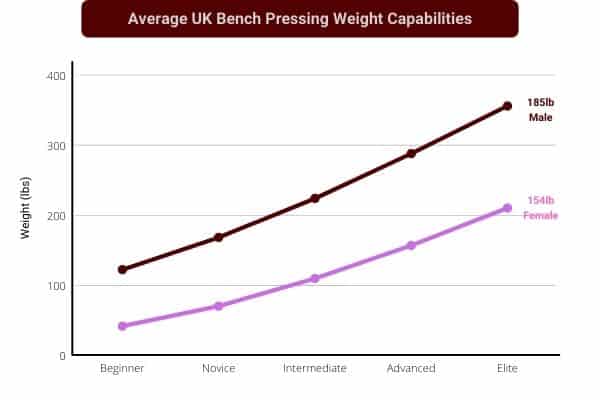
If you are lifting near or above these bench press standards, then you can be sure that you’re doing a good job!
If your bench press is below average, then you may be interested in my dumbbell chest strength program.
6) Bench Press Equipment Preference Statistic
Key bench press stats:
- 50% of people prefer to alternate between barbells and dumbbells for bench press training.
- 48% of people prefer to use dumbbells when bench press training.
- Only 2% of people prefer to use barbells exclusively when bench press training.
The bench press is most commonly performed using free weights- either a barbell or dumbbell.
So to determine the most popular way to bench press, I tracked down this Reddit poll and compiled the responses:
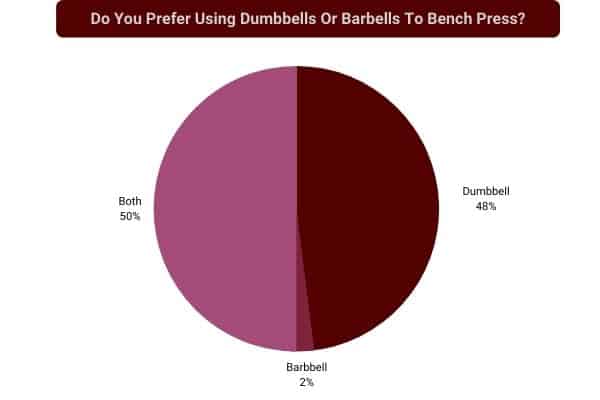
Out of the 36 total user responses, 18 users (50% of total responses) said they preferred using combining dumbbells AND barbells in their training.
Of the remaining 18 users, 15 (48% of total responses) stated they preferred to use dumbbells exclusively. And only 3 (2% of total responses) stated they prefer using barbells exclusively.
This isn’t surprising, given the unique benefits offered by both types of free weight.
Dumbbells allow for a greater range of motion, more muscle stretch, and a better muscle growth stimulus.
Barbelsl on the other hand allows you to lift more weight for greater strength gains.
You can check out my other posts for full details on the benefits of using dumbbells and the advantages of barbell training.
7) Bench Press Range Of Motion Preference Statistic
Key bench press stats:
- 83% of people perform the bench press with a full range of motion, allowing the weight to reach chest level before pressing upwards.
- 17% of people perform the bench press with a half range of motion, allowing the weight to reach the point where the elbows are at a 90° angle before pressing upwards.
Bench press range of motion (ROM) describes how much your arm moves around your shoulder joint throughout the exercise.
A full-ROM is achieved when the elbows drop fully below the chest line and the weight reaches chest level.
In contrast, a partial-ROM describes when you complete a half-rep.
To find out how low people go when bench pressing, I compiled the responses from this Bodybuilding poll.
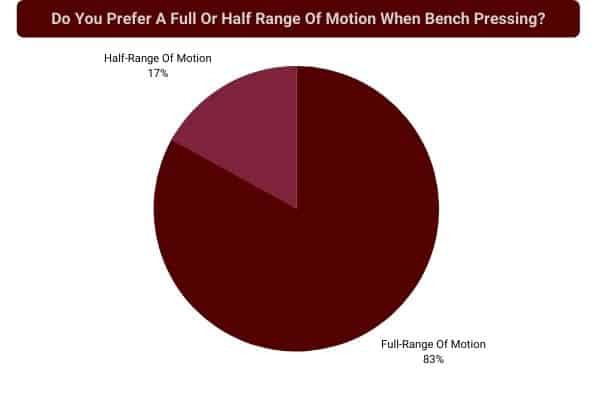
Out of 207 responses, only 35 people (17%) lift with a partial-ROM. The majority 172 people (83%) prefer to lift with a full-ROM.
Lifting with a full-ROM is generally recommended. Moving through a full ROM will make the bench press harder, but also more effective for pectoral activation.
8) Bench Angle Muscle Activation Stat
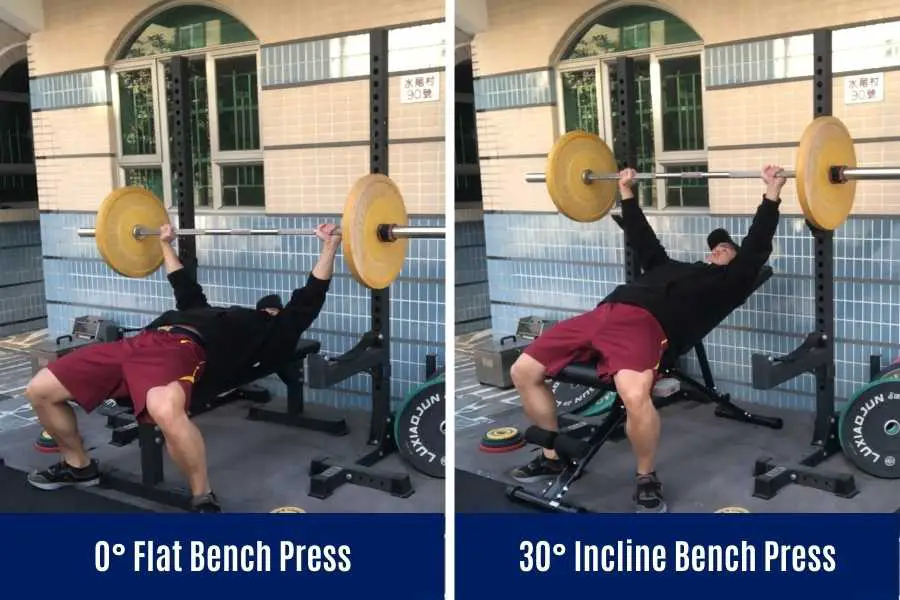
Key bench press stats:
- A 0° flat bench press activates all three chest regions equally.
- The 30° incline bench press activates the upper chest 30% more than the flat bench press.
A popular way to add variety to a bench press is by altering the bench press angle. And this is done to isolate tension to the upper, mid, or lower pectoral muscles (thereby training the different chest regions).
Two of the most popular bench press angles are the flat and incline bench press.
So how do these bench press angles emphasize the different regions of the chest?
A 2020 study sought to determine how bench angle affects msucle activation in the 3 pectoral regions.
The scientists attached electrodes to the upper, mid, and lower chest of 30 male participants as they bench pressed at different incline angles (0°, 15°, 30°, 45°, and 60°).
This allowed the scientists to measure the muscle activity in the upper, mid, and lower pecs.
And here are the results:
- 0° flat bench press- activates all three pec regions equally.
- 30° incline bench press- activates the upper pecs the most (30% more than the flat bench press).
- 60° incline bench press- activates the front shoulders the most (33% more than the flat bench press).
A good adjustable bench allows you to bench press at different angles at home to target your upper chest!
9) Bench Press Grip-Width Stat
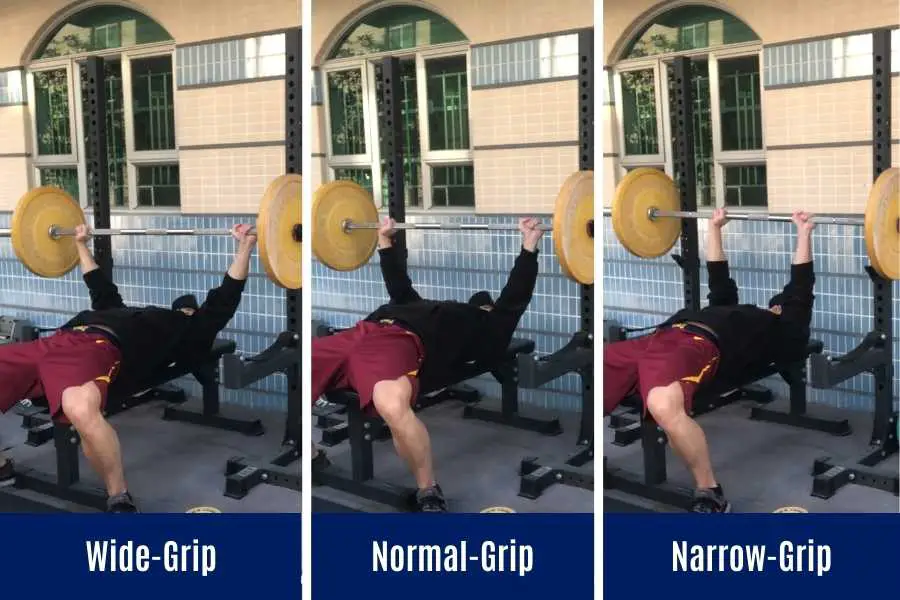
Key bench press stats:
- Wide-grip bench pressing allows 0.8% more weight to be lifted, compared to standard-grip bench pressing.
- Wide-grip bench pressing allows 5.7% more weight to be lifted, compared to narrow-grip bench pressing.
- Standard-grip bench pressing allows 4.8% more weight to be lifted, compared to narrow-grip bench pressing.
Grip-width is another popular way to add variety to a bench press. Adjusting your grip can also affect how much weight you can lift.
A 2021 study determined how grip width affects bench pressing strength.
14 males were asked to perform bench presses using a narrow, standard, and wide grip. And 1-rep max was recorded.
This allowed the scientists to record the maximum weight each participant could bench press.
Here are the results:
- Wide-grip bench press- averaged 109.8kg
- Standard-grip bench press- averaged 108.9kg.
- Narrow-grip bench press- averaged 103.7kg.
You can check out my other post to learn how to choose the correct lifting weight to build a stronger chest.
10) Bench Press Vs Chest Fly Pectoral Activation Stat
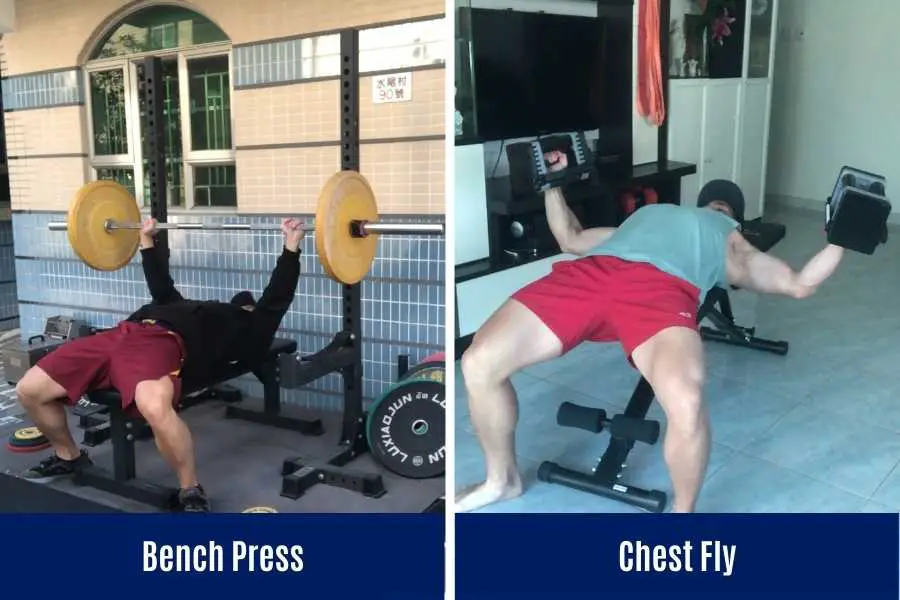
Key bench press stats:
- The barbell bench press activates the pectorals 16% more than the dumbbell chest fly.
The bench press is arguably one of the most popular exercises to get a bigger chest, closely followed by the dumbbell chest fly.
So how do the two exercises compare?
A 2020 study addressed this question.
17 males were asked to perform bench presses and chest flyes, with electrodes attached to the upper, mid, and lower pecs.
This allowed pectoral muscle activation to be recorded as the participants performed each exercise.
Here, the scientists found that the bench press elicited a 16% higher pectoral activation, compared to the chest fly.
Conclusion
That’s 10 of my favorite bench press statistics and scientific findings for 2023.
They can help you to benchmark your own bench pressing progress and the scientific findings can be applied to your own training.
You may also be interested in the downloadable Kalibre Blueprint PDF which details exactly how I gained 40lbs of lean muscle (it’s 100% free!). It details the exact exercises and nutrition (with printables) I used to go from skinny to ripped!


